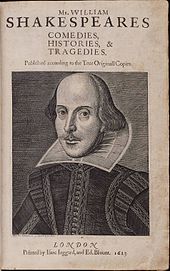- Martin Droeshout
-
Martin Droeshout (pronounced /ˈdruːʃaʊt/) (April 1601 – 1650) was an English engraver of Flemish descent, whose fame rests completely on the fact that he made the title portrait for William Shakespeare's collected works, the First Folio of 1623, edited by John Heminges and Henry Condell, fellow actors of the Bard.
In addition to portraits (for example those of John Foxe, John Howson or George Villiers, 1st Duke of Buckingham) Droeshout also made engravings of allegorical, mythical and satirical topics.[1] Some time between 1632 (his last known signed and dated English print) and 1635 (his first known signed and dated Spanish print), Martin Droeshout moved to Madrid and anglicised his name to "Droeswood" ("hout" being Dutch for "wood").[2]
The exact identity of Droeshout is uncertain, since there were two Martin Droeshouts who could have been the engraver. Traditionally, the engraver is assumed to be Martin Droeshout the Younger (born 1601), but the attribution has also been made to his uncle, Martin Droeshout the Elder (1560s–c. 1642), an attribution accepted by the Oxford Dictionary of National Biography.[3]
Which Martin Droeshout?
Most sources state that the engraver was Martin Droeshout the Younger (b. 1601), the son of Michael Droeshout, an immigrant from Brussels. Except for his date of birth and parentage, very little is known about Martin the Younger, but since his father was an engraver, it has been assumed that Martin followed in his father's footsteps, and that he made the engraving of Shakespeare. As he was 15 when when Shakespeare died, he may never have seen him and it has been assumed that he worked from an existing image.[4]
Research by Mary Edmond into the Droeshout family revealed new information about Martin Droeshout the Elder, who was the uncle of the younger Martin. Edmond shows that Droeshout the Elder was a member of the Painter-Stainer's Company. Edmond writes,
- "It seems perverse to attribute the Shakespeare engraving to the obscure and unsuitably young Martin Droeshout, born in 1601, as is customary, when there is a quite well-documented artist of the same name to hand, in the person of his uncle".[5]
Edmond also points out that Droeshout the Elder seems to have had an association with Marcus Gheeraerts the portraitist, and notes that there is evidence that a portrait of Shakespeare by Gheeraerts may have once existed. She surmises that Droeshout's engraving may have derived from this lost portrait.[6]
More recently, June Schlueter has found evidence that Martin the Elder was in London when the engraver of the First Folio portrait was known to be in Madrid.[7] Although she began her archival research hoping to prove Edmond's assertion that the elder Martin was the Shakespeare engraver, Schlueter concludes that the newly discovered evidence actually supports the younger.[8]
The traditional attribution to Droeshout the younger is made on stylistic grounds. Droeshout the elder is generally held to be a more skilled artist than his nephew, and the clumsy features of the depiction of Shakespeare's body resemble other prints by Droeshout the Younger. The attribution to the younger artist is provisionally accepted by the National Portrait Gallery, which argues that the poor modelling of the doublet suggests that Droeshout was copying a lost drawing or painting which only depicted Shakespeare's head and shoulders. The body was added by the engraver himself, as was common practice.[4]
Notes
- ^ , Godfrey, Richard T., Printmaking in Britain : a general history from its beginnings to the present day, New York: New York University Press, 1978.
- ^ Christian Schuckman, "The Engraver of the First Folio Portrait of William Shakespeare", Print Quarterly, VIII: 1 (1991), pp. 40-43 and June Schlueter, "Martin Droeshout Redivivus: Reassessing the Folio Engraving of Shakespeare", Shakespeare Survey 60. Cambridge: Cambridge University Press, 2007, pp. 237-251.
- ^ Mary Edmond, "Droeshout, Martin (1565x9–c.1642)", Oxford Dictionary of National Biography, Oxford University Press, 2004 accessed 25 April 2007.
- ^ a b Tarnya Cooper, Searching for Shakespeare, National Portrait Gallery; Yale Center for British Art, p.48.
- ^ Mary Edmond, "It was for gentle Shakespeare cut". Shakespeare Quarterly 42.3 (1991), p. 343.
- ^ Mary Edmond, "It was for gentle Shakespeare cut". Shakespeare Quarterly 42.3 (1991), p. 344.
- ^ June Schlueter, "Martin Droeshout Redivivus: Reassessing the Folio Engraving of Shakespeare", Shakespeare Survey 60. Cambridge: Cambridge University Press, 2007, p. 240.
- ^ June Schlueter, "Martin Droeshout Redivivus: Reassessing the Folio Engraving of Shakespeare", Shakespeare Survey 60. Cambridge: Cambridge University Press, 2007, p. 242.
External links
- "Website Comparing the Three most likely Shakespeare Portraits"
- Works by Martin Droeshout the Younger at the National Portrait Gallery, London
Portraits and sculptures of William Shakespeare Portraits Artists - Martin Droeshout
- John Taylor
- Nicholas Hilliard
- Karel van Mander
- Gerard Soest
- William Marshall
- Angelica Kauffmann
- George Romney
- Ford Madox Brown
- Pablo Picasso
- Andy Warhol
Sculptures Sculptors - Gerard Johnson
- Peter Scheemakers
- Louis-François Roubiliac
- Thomas Banks
- John Quincy Adams Ward
- William Ordway Partridge
- Frederick William MacMonnies
- Lord Ronald Gower
- Paul Fournier
- Louis Hasselriis
- Edgar Bertram Mackennal
Categories:- 1601 births
- 1650 deaths
- English engravers
- Portraits of William Shakespeare
Wikimedia Foundation. 2010.

